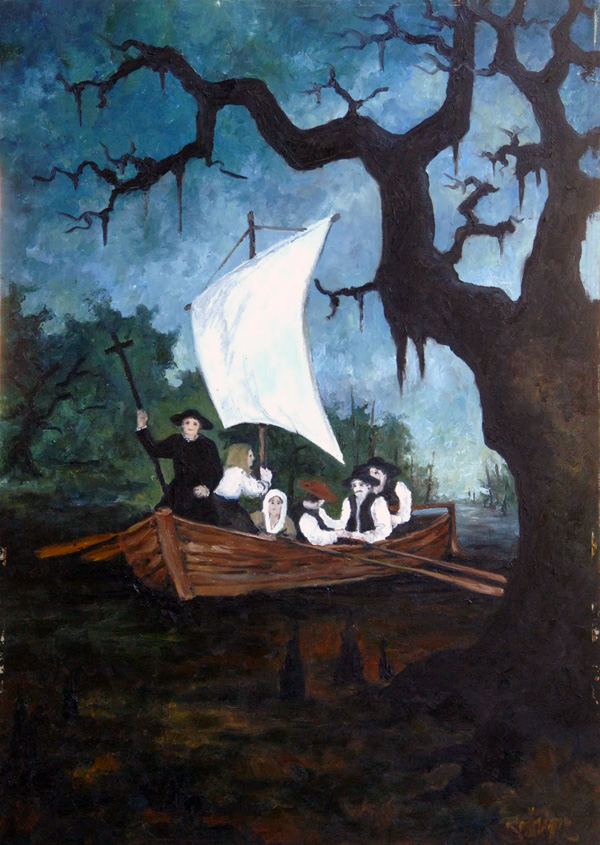Acadians in Colonial Louisiana
The Acadians, ancestors of present-day Cajuns, were people of French ancestry who settled in what is now Canada before migrating to Louisiana.
This entry is 6th Grade level View Full Entry

Courtesy of George Rodrigue.
The First Cajuns. Rodrigue, George (Artist)
Cajuns are the descendants of Acadian exiles from what are now the Maritime provinces of Canada—Nova Scotia, New Brunswick, and Prince Edward Island—and other ethnic groups with whom they later intermarried in South Louisiana. Today Cajuns reside primarily in a twenty-two-parish region of southern Louisiana known as Acadiana. Significant numbers of Cajuns also live in neighboring Allen and Jefferson Parishes as well as in southeastern Texas, particularly around Beaumont, Port Arthur, and Orange. Although best known outside Louisiana for their flavorful food and unique music, Cajuns have made many important contributions to Louisiana’s history and culture.
Where did the Acadians come from?
The Cajuns’ early ancestors were known as the Acadians, most of whom were from the Centre-Ouest region of France, on the Atlantic coast. The first families in Acadia (present-day Nova Scotia, New Brunswick, and Prince Edward Island, Canada) had surnames still familiar today in southern Louisiana: Boudreaux, Bourgeois, Breaux, Comeaux, Cormier, Doucet, Girouard, Hebert, LeBlanc, Theriot, and Thibodeaux, among others. These families arrived in Acadia in the early to mid-1600s, more than a quarter of a century after French explorers established the colony to engage in the fur trade with the local Native Americans.
The Acadians came to the New World for several reasons. Religious violence rocked France, and people living there also suffered from disease, poverty, famine, and drought, as well as heavy taxation. The Acadians not only left France to escape these hardships but also to acquire their own land, which they considered essential to personal liberty and happiness.
Settling in Acadia along the Bay of Fundy, the Acadians developed an ingenious dike, or levee, system for reclaiming fertile coastland from the sea. Although fur trapping remained an important part of the local economy, many Acadians became subsistence farmers, growing what they and their families needed to survive and producing only a small surplus for trade. The Acadians thrived in their new homeland. Between 1654 and 1755, the colony’s estimated population grew from about 325 to about 15,000 settlers.
The Acadians occupied lands considered strategically important by both France and its major rival, Great Britain. As a result, in the century after its founding, the colony passed back and forth between France and Great Britain ten times! In 1710 the British captured Acadia permanently, cementing their victory three years later in the Treaty of Utrecht, which allowed the Acadians to either leave the colony with their property or to remain on their farms. The treaty also allowed the Acadians to practice their Roman Catholic faith. Moreover, a 1713 decree gave the Acadians full property rights in Acadia—which the British had then renamed Nova Scotia (Latin for New Scotland).
Why were the Acadians expelled from Nova Scotia?
Despite these generous terms, the British pressured the Acadians to swear an unconditional oath of allegiance to the British Crown. The Acadians refused to swear this oath unconditionally, but they did offer their allegiance under one condition: the British had to grant them neutral status during wars. The colonists viewed wartime neutrality as vital to their safety, since siding with the British would invite attacks from both the French and Native Americans.
For decades the British continued to press the Acadians to swear an unconditional oath of allegiance. Finally, Lieutenant Governor Charles Lawrence used the issue as an excuse for expelling every Acadian from Nova Scotia. Lawrence wanted to deport the French-Catholic Acadians because he feared they would revolt if a war with France ever erupted. He also coveted the Acadians’ valuable farmlands, which he intended to give to loyal Anglo-Protestant colonists.
Lawrence planned the expulsion of the Acadians with William Shirley, governor of the Massachusetts colony, which provided British troops and ships for the operation. Lawrence launched the expulsion in the summer of 1755. He summoned Acadian men to the capital at Halifax to discuss the return of their firearms, which British troops had earlier seized. However, British troops arrested the Acadian men who came. Meanwhile, other British soldiers spread across the colony, using similar deceptions to round up the remaining Acadians. For example, at the town of Grand Pré, British troops lured more than four hundred Acadian men into the local church, which became their prison while soldiers prepared Acadian women and children for deportation.
British soldiers under Lawrence’s command captured Acadians throughout the colony, marching them at gunpoint to the coast, dividing them according to age and sex, and loading them aboard overcrowded transport ships. Lawrence sent these ships to distant lands, scattering the Acadians throughout the British colonies of North America and beyond. Because it was a deliberate attempt to destroy an ethnic group, historians consider the expulsion—known in French as Le Grand Dérangement, or the Great Disturbance—an instance of genocide and ethnic cleansing. Some historians estimate that as many as half of the approximately fifteen thousand Acadians died from exposure, disease, starvation, and violence related to their deportation.
How did some of the Acadians end up in Louisiana?
In 1764, after nearly a decade of wandering, one group of Acadian exiles found its way to Louisiana, a French colony recently transferred to Spanish control. The colony’s French caretaker government, acting temporarily on behalf of the Spanish, welcomed the exiles. Those caretakers provided them with land, livestock, tools, and other necessities and settled them in the fertile, semitropical region known as Attakapas in south-central Louisiana. Some of these first Acadians in Louisiana wrote to other, distant groups of exiles, providing glowing descriptions of their new homes. (Although a largely nonliterate people, some Acadians were able to read and write, and those who could not were able to find someone to read or write for them.)
Stirred by these letters, other exiles made their way to Louisiana during the ensuing decades, arriving from Maryland, Pennsylvania, New York, and France, among other places. When the colony’s Spanish governor, Antonio de Ulloa, forced some of the exiles to settle on the Mississippi River near present-day Natchez, Mississippi, far from their Attakapas kin, the Acadians marched on New Orleans with other angry colonists and overthrew the governor in the Insurrection of 1768.
In total about three thousand Acadian exiles eventually made their way to Louisiana. Like their ancestors, these exiles remained subsistence farmers, producing only enough material goods to survive. Within a few generations, however, a small number of young Acadians adopted the South’s plantation system and its brutal institution of slavery. By the 1810s the Acadians had evolved from a single group of poor subsistence farmers into three distinct groups. First, there was a small group of wealthy, slave-owning cotton and sugar planters, who would later be called “genteel Acadians.” Second, there was a small group of middle-class Acadians made up of farmers and artisans, including blacksmiths, carpenters, and bricklayers. Members of this group might have owned a few enslaved people but certainly not as many as planters. Finally, a very large number of Acadians continued to labor as subsistence farmers, often without the assistance of enslaved persons (though these Acadians were known to sometimes rent enslaved laborers from wealthier landowners).
While upper- and middle-class Acadians increasingly adopted the customs of the region’s elite French Creoles and new Anglo-American settlers, poor Acadians preserved the values and traditions of their ancestors. It was from this mass of poor Acadians—and all the other ethnic groups with whom they intermarried in South Louisiana—that the Cajun people would spring.
